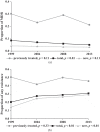Drug-resistant tuberculosis in Zhejiang Province, China: an updated analysis of time trends, 1999-2013
- PMID: 28578621
- PMCID: PMC5496046
- DOI: 10.1080/16549716.2017.1293925
Drug-resistant tuberculosis in Zhejiang Province, China: an updated analysis of time trends, 1999-2013
Erratum in
-
Erratum.Glob Health Action. 2017;10(1):1395149. doi: 10.1080/16549716.2017.1395149. Glob Health Action. 2017. PMID: 29072113 Free PMC article. No abstract available.
Abstract
Background: Multidrug-resistant tuberculosis (MDR-TB) and extensively drug-resistant tuberculosis (XDR-TB) hinder the progress of TB control.
Objective: To track the trend of drug-resistant tuberculosis (DR-TB) prevalence in Zhejiang Province from 1999 to 2013, and identify risk factors of resistance to second-line drugs among MDR-TB patients.
Design: Four DR-TB surveys had been done in Zhejiang Province in 1999, 2004, 2008 and 2013 through questionnaires, in which demographic and epidemiological items were included. After questionnaires, drug susceptibility testing (DST) targeted at four first-line drugs was done for all TB patients and DST targeted at six second-line drugs (only in 2008 and 2013) for MDR-TB patients. The drug resistance trend over time was analyzed using the Cochran-Armitage test. The factors associated with resistance to second-line drugs among MDR-TB patients were examined by a multivariate logistic regression model.
Results: Of 936 patients enrolled, 27 (3.21%) and 20 (21.28%) MDR-TB cases were registered as new and previously treated cases, respectively. MDR-TB showed a decreasing trend (Z = -3.31, p < 0.01) while resistance to any first-line drugs showed an increasing trend (Z = 5.22, p < 0.001), from 1999 to 2013. The highest resistance rate was shown to ofloxacin among MDR-TB patients both in 2008 (28.8%) and in 2013 (27.7%), while resistance to para-aminosalicylate decreased significantly (Z = -2.06, p = 0.04) between 2008 and 2013. MDR-TB patients aged 45-65 years (OR = 5.00, p = 0.02) were more likely to be resistant to any second-line drugs.
Conclusions: DR-TB including MDR-TB remains a major public health problem in Zhejiang Province. Further efforts on MDR-TB control should be conducted to hinder drug resistance, including critical clinical use of anti-TB antibiotics and preventing transmission.
Keywords: multidrug resistant TB; second-line drug resistance; surveillance.
Figures
References
-
- World Health Organization Global tuberculosis report 2015. Geneva: The Organization; 2015.
-
- Zhao Y, Xu S, Wang L, et al. National survey of drug-resistant tuberculosis in China. New England J Med. 2012;366:2161–7. - PubMed
-
- Espinal MA, Kim SJ, Suarez PG, et al. Standard short-course chemotherapy for drug-resistant tuberculosis: treatment outcomes in 6 countries. Jama. 2000;283:2537–2545. - PubMed
-
- Gandhi NR, Nunn P, Dheda K, et al. Multidrug-resistant and extensively drug-resistant tuberculosis: a threat to global control of tuberculosis. Lancet. 2010;375:1830–1843. - PubMed
-
- Lönnroth K, Castro KG, Chakaya JM, et al. Tuberculosis control and elimination 2010–50: cure, care, and social development. Lancet. 2010;375:1814–1829. - PubMed
Publication types
MeSH terms
Substances
LinkOut - more resources
Full Text Sources
Other Literature Sources

